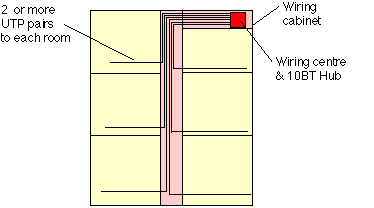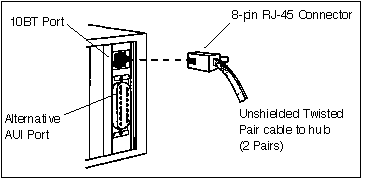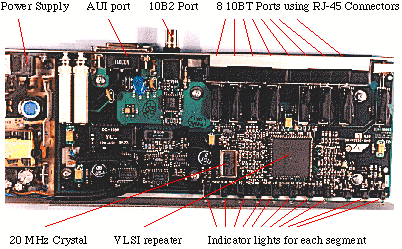
An extension to the IEEE specifications allows Ethernet to use a low-cost Unshielded Twisted Pair (UTP) cable.
This type of cable is very cheap to purchase and is flexible and also still easy to install. It has come to be used by other networking systems (including telephony) and is the most common type of cable infrastucture.

The UTP cabling system uses a RJ-45 connector and 100 Ohm unshielded twisted pair cabling. This connects the computer directly (i.e. using a point to point link) to a wiring hub, which functions as an Ethernet repeater. The maximum distance of a UTP link is 100 m.
UTP is normally used as a structured cable system to connect work groups of users. Often an entire outlets are provided to each work area, and the cable brought back to a central wiring position for all offices on the same floor of a building (known as a patch panel). The diagram below shows the UTP cable (with an RJ-45 connector plug) and the socket for the cable on an network interface. In this case the cable forms a point-to-point connection between the computer and a hub/switch.

The use of UTP for Ethernet at 10 Mbps is known as 10 BasebandT (10BT), indicating. This is specified for baseband communications (i.e. not modulated) at 10 Mbps using twisted pair cabling.
A 10BT hub is a repeater with a number of 10BT ports. Some hubs (e.g. the one shown below) also have an Transceiver AUI port or 10B2 port that allows connection to other media.

An installed UTP Category 5 cabling system may be used to support Fast Ethernet by simply changing the equipment installed at both ends of the cable. The enhanced specification of Cateogory 5e (a common standard for installation) also supports Gigabit Ethernet. A higher specification of cable, Category 6, is required for 10 Gigabit Ethernet.
A summary of the properties of this type of cabling is given below:
The UTP cable standard continues to develop.
CAT-6 cables use thicker wires that are much more tightly twisted with a cross-shaped former in centre and better cable insulation. This offers 250 MHz bandwidth(although 10BASE-GT limits cable length to 55m).
CAT-6a extends this bandwidth to 500 MHz and enables 10BASE-GT to operate Ethernet links at 10 Gbps over lengths up to 100m.
CAT7a copper UTP offers a signal bandwidth of around 1600 MHz (using Shielded SFTP).This cabling targets data centre applications, rather than home/enterprise applications.
CAT8 copper UTP offers a signal bandwidth of around 2000 MHz (using SFTP).
100Gbps, 200 Gbps and 400 Gbps Ethernet specifications are being prepared by industry.
Information about LAN equipment including 10BT Hubs
Fast Ethernet over UTP
Gigabit Ethernet over UTP